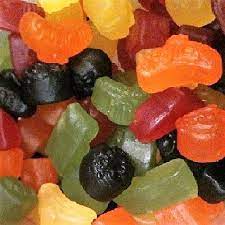
Those of you that spend a lot of time behind the wheel of a car may be able to identify with the notion of a “favourite travel sweet”; the candy that makes the journey all the more bearable. I complete approximately 1,000 miles every fortnight (a 500 mile round trip on the Friday to pick my son up and bring him home, and then the same trip to drop him back to his Mum’s on the Sunday) and when my wife and I travel away our sweet of choice is the Wine Gum. Preferably the Maynards Wine Gum; other confectioners versions are available but not as gummy (or winey).
As I progress through life, (notice how I have avoided the phrase “get older”) I have come to observe, like many of you, how chocolate bars have gotten smaller (and more expensive), the tubs of Christmas chocolates (Roses, Quality Street, etc) have shrunk and how many of my childhood favourites are no longer available. But having spent so much time in the company of the humble wine gum my wife and I have noticed that there seems to be a regular penchant for an over proliferation of a certain colour; red. The red wine gum, whilst wholly acceptable and edible, is not our favourite (my wife’s being yellow and mine being black) but seems to outnumber the other flavours/colours on an all too regular basis.
An opportunity then, for a statistical study of the contents of the Maynards Wine Gum offering. For the sake of scientific continuity, all of the bags in our study were purchased from one supplier (Tesco) and were the same size; although here I offer my apologies, as I can’t recall the size of the bag, all I can do is mention the number of sweets in each when providing the results.
So, all good studies should start with a statement that is proven/disproven by the findings; in our case “the dominant colour in a bag of wine gums is red”. The statistical analysis for this study was undertaken by my son, Ollie, on the return leg of one of our 500 mile Sundays –
FINDINGS
In all 3 sample bags the majority colour was indeed RED; 32% of the contents of Bag #1, 30% of Bag #2 and a whopping 41% of Bag #3. So our suspicions were correct ! But, interestingly, the proportion of the other colours in the bag was also pretty constant; Yellow seemed to be the next most prolific colour, Orange and Green were relatively similar in numbers and Black was, by far, the least underrepresented colour.
All three bags contained the same number of wine gums (66).
| BAG 1 | BAG 2 | BAG 3 | TOTAL | |||||
| # | % | # | % | # | % | # | % | |
| BLACK | 6 | 9 | 7 | 11 | 8 | 12 | 21 | 11 |
| RED | 21 | 32 | 20 | 30 | 27 | 41 | 68 | 34 |
| GREEN | 15 | 23 | 10 | 15 | 10 | 15 | 35 | 18 |
| ORANGE | 13 | 20 | 12 | 18 | 10 | 15 | 35 | 18 |
| YELLOW | 11 | 17 | 17 | 26 | 11 | 17 | 39 | 20 |
| 66 | 66 | 66 | 198 | |||||
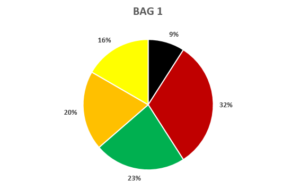
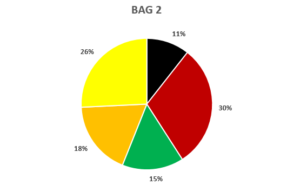
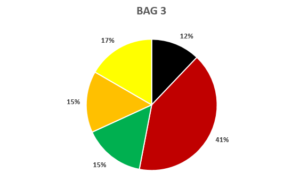
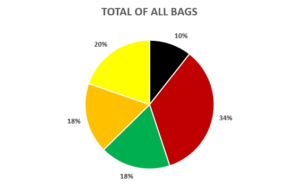
I contacted the Consumer Care team at Mondelez (the parent company responsible for Maynards Wine Gums) with our findings and asked whether the packaging processes for the product would explain the statistics.
Within a few days, the lovely Sofia from the Consumer Care Team responded –
“Dear Nick,
Thank you for contacting us.
The assortment of units in this product is completely random. They are made and mixed together in large drums where they are then deposited either into rolls, bags or boxes depending on the pack size. It is not possible therefore to guarantee the number of each unit in any one pack. We are constantly reviewing our manufacturing techniques and please be assured that details of your complaint have been duly noted for continuous improvement purposes.
Whilst we cannot guarantee an equal ratio in each pack we hope you will continue to enjoy our products. We loved your detailed research and graphs!
Thank you once again for contacting us.”
Curious ! Perhaps then, there is some correlation to the shape of the sweet rather than the colour/flavour – it looks as though there is another statistical study coming ! Looks like we’re going to buying another 3 bags of wine gums – all in the name of science of course !




Recent Comments